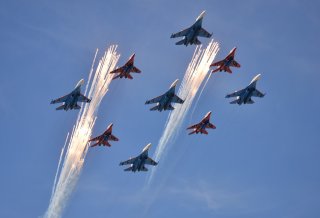Russia’s Su-27 Fighters Wreak Absolute Havoc in the Baltics
The Kaliningrad Flankers are arguably the busiest—and most dangerous—Su-27s anywhere in the world.
Here's What You Need to Remember: Russia's Kaliningrad Flankers patrol over the Baltic, intercept NATO and neutral spy planes in international air space and, on occasion, harass the rival planes so aggressively that they have no choice but to flee. If any Russian warplanes end up causing an international incident in the tense Baltic region, it will likely be the Kaliningrad Su-27s.
On June 9, 2017, examples of all three of the U.S. Air Force’s heavy bombers — the swing-wing B-1, the stealthy B-2 and the lumbering B-52 — gathered in international air space over the Baltic Sea for a rare photo-op with allied fighters and patrol planes.
They had a surprise visitor. A Russian air force Su-27 Flanker fighter sidled up to the U.S.-led formation and flew alongside long enough to appear in multiple photos. A few days prior, an Su-27 intercepted a B-52 over the Baltic.
The Su-27 was apparently one of seven Flankers that fly from Kaliningrad, Moscow’s Baltic enclave, sandwiched between Lithuania and Poland and geographically separate from the rest of Russia.
The Kaliningrad Flankers are arguably the busiest—and most dangerous—Su-27s anywhere in the world.
They patrol over the Baltic, intercept NATO and neutral spy planes in international air space and, on occasion, harass the rival planes so aggressively that they have no choice but to flee.
If any Russian warplanes end up causing an international incident in the tense Baltic region, it will likely be the Kaliningrad Su-27s.
Over the Baltic on Oct. 3, 2014, an Su-27 with the numeral 24 on its nose in red paint flew so close to a Swedish air force Gulfstream spy plane—around 30 feet, according to Combat Aircraft’s Babak Taghvaee—that the Swedish crew could clearly identify the Russian jet’s weapons, including four R-27 and two R-73 air-to-air missiles.
In June 2017, Russia’s defense minister Sergey Shoigu was flying to Kaliningrad when a Polish F-16 intercepted the minister’s transport plane. A pair of Su-27s — likely from the enclave — intervened.
A few days later, an apparent Kaliningrad Su-27 with the nose code Red 93 flew so close to a U.S. Air Force RC-135 spy plane that the Pentagon formally complained.
While for many decades opposing air arms have routinely intercepted each other’s planes in international air space, NATO and Swedish authorities have grown increasingly concerned over Moscow’s actions in the Baltic region.
Russian aerial activity in the Baltic region has been on the rise for years — and escalated sharply following Russia’s invasion of Ukraine in early 2014. Fighters from NATO and neutral countries have intercepted Russian planes on hundreds of separate occasions since then.
“We have seen examples of the actions of air power that can be perceived as more aggressive than what we’ve seen in a long time,” army general Sverker Goranson, then Sweden’s top officer, told a Swedish news outlet in 2014.
In June 2014, Kaliningrad Su-27s again flew within 30 feet of a Swedish spy plane. The Su-27s have also tangled with Swedish Gripen fighters and French Mirage jets. The Flankers have repeatedly intercepted, and occasionally endangered, American RC-135s.
In July 2014, an RC-135 was presumably monitoring electronic signals from the Russian enclave when at least two of the resident Su-27s—which as of 2014 included three Su-27SM3s, one Su-27P and an Su-27S, among others—vectored for an intercept.
Something about the Flankers’ behavior frightened the American aircrew. The RC-135 turned and ran—straight into Swedish territory. “The U.S. aircraft was directed towards Swedish air space incorrectly by U.S. personnel,” the Pentagon’s European Command said in a statement.
Five months later in September 2014, the Kaliningrad Flankers—which the Russian air force detached from the 6972nd Aviation Base in Krasnador, just north of the Black Sea—took part in a massive exercise that tested the Kremlin’s ability to reinforce Kaliningrad with scores of extra warplanes and hundreds of paratroopers.
War games have become commonplace off Kaliningrad. In July 2017, Russian and Chinese warships conducted mock naval combat off Kaliningrad. And Russia staged parts of its sprawling Zapad exercise in Kaliningrad in September 2017.
Russian Flankers have also escorted heavy bombers conducting mock attack runs on European countries—although it’s not entirely clear that those Su-27s came from Kaliningrad.
David Axe served as Defense Editor of the National Interest. He is the author of the graphic novels War Fix, War Is Boring and Machete Squad.
This article is being republished due to reader interest. It originally appeared at War is Boring.
Image: Reuters.

